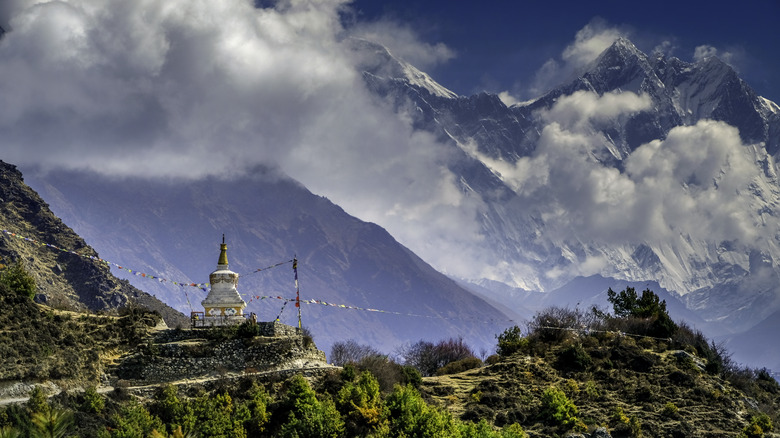Here's How Long It Really Takes People To Climb Mt. Everest On Average
To climb Mount Everest, you're going to need a healthy savings account, as summit expeditions start at around $35,000 – the permit alone is $11,000. But you're also going to need to start saving up vacation days, because the entire expedition can take two to three months. And that's not including the many, many months spent training for such a physically taxing feat. Some aspiring mountaineers even go so far as to move to Colorado to practice by summiting that state's "14ers," the collection of 48 mountains in that state with summits over 14,000 feet. So your journey may start months and miles away from Nepal.
Once you've gotten yourself to Kathmandu, you will obtain your permit then fly to the town of Lukla to begin the trek, and unless you do live someplace like Denver, you'll need a few days to acclimate before setting out, because Lukla sits at over 9,000 feet elevation. You have around 20,000 feet to go to reach Everest's summit. But most of your time won't be spent hiking or climbing. You'll be taking a lot of breaks to acclimate to altitude as you get progressively higher. So relax, sit down, and have a cup of tea. And once you're at Everest Base Camp (that's "EBC" in Everest lingo), most of your time will be spent waiting for weather.
Everest is one of the hardest ascents in mountaineering, but EBC is a trekking destination on its own. The small weather window for summiting happens in May, but if you're only doing the EBC trek, you can hike between March and May or September and November without winter winds or summer monsoons interfering. This trek can be done in a couple of weeks.
The trek to Everest Base Camp
7,000 individuals have climbed Mount Everest, some, like guides and sherpas, multiple times, with up to 800 succeeding in a good year, and over 300 have died trying. But a staggering 40,000 people trek to Everest Base Camp in Nepal, at 17,598 feet, every year. This is one of the greatest treks in the world. It's also grueling, not because it's technically difficult, but because the altitude gains wreak progressive havoc on your body. One Redditor returning from an organized tour reported: "One girl in my group lost eyesight in one eye because of the altitude, another person I know had a stroke/had to be airlifted — I saw more vomit than I cared to. The teahouse dining hall at the top looked like a bunch of dead bodies just laying around."
The good news? It won't wreak nearly as much havoc on your wallet, with organized treks available for around $1000. "Teahouse trekking" from Lukla to EBC can be quite civilized, as you hike a few hours each day, from inn to inn. You'll only sleep in a tent at EBC itself.
A typical itinerary on a guided trek from Lukla to EBC and back takes around 14 days, with two "zero" days of rest along the way to allow your body to adjust. When it comes to altitude, fit people don't necessarily fare better than out of shape people — everyone responds differently, so you shouldn't count on powering through any faster just because you can flip a tractor tire with one pinkie finger at your local Crossfit box. As you climb, you'll see ravishing scenery and visit villages and centuries-old monasteries. Complete itineraries can take around 14 days to cover 80 miles.
From Everest Base Camp to the summit
Once you've hiked in, expect to spend around 40 days at Everest Base Camp over the course of a summit attempt. The season for climbing Everest is short, from mid-April through late May (another briefer and less popular season happens in November), outside of which time hurricane-force winds and sub-zero temperatures rule. But expeditions are typically waiting at EBC for one of the few, brief "summit windows" to open up, when temperatures warm and winds die down to below 25 mph.
The wait time is spent doing some final training climbs. Prior to summiting, climbers make at least two climbs to camps numbered I-IV higher up the mountain, to condition their bodies to the increased altitude. Past Camp II, you may need supplemental oxygen from a tank. Sherpas will have already scouted the route, which changes slightly every year, and fixed ropes to clip into on your ascent — in 2024, when a snow cornice collapsed, climbers who were clipped in survived, while two who weren't fell to their deaths.
When you're conditioned, and the weather looks promising, you'll ascend to Camp II to wait there. During the actual summit attempt, you'll spend day one reaching Camp III, day two reaching Camp IV, and then on day three, you'll attempt the summit, observing the 2 o'clock rule, which dictates you must summit by 2 p.m. before the winds pick up, or turn back and start all over again. Even if you succeed, accidents are more likely while descending, when you're tired and careless. But the good news is that, once you're standing on top of the world, going down is a lot faster, and you could be back in Lukla in as little as a week.


